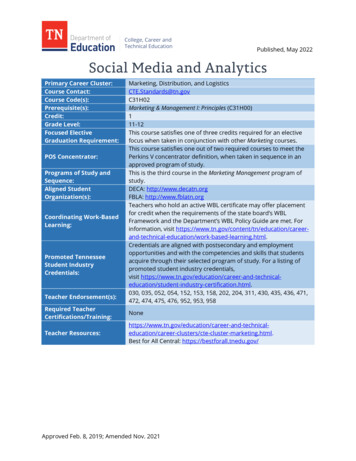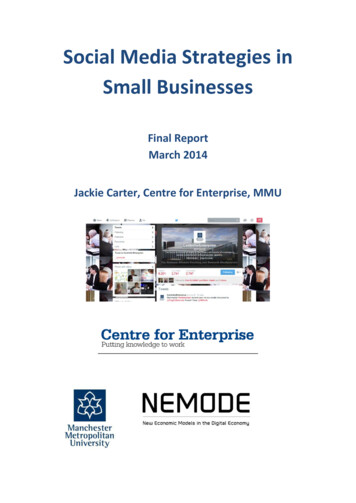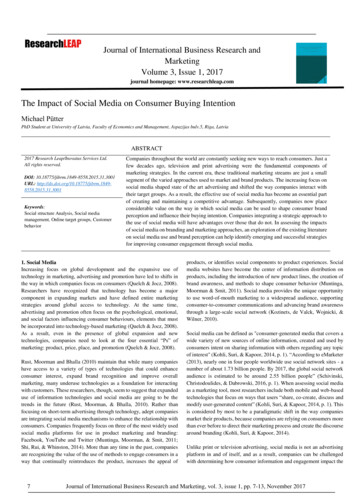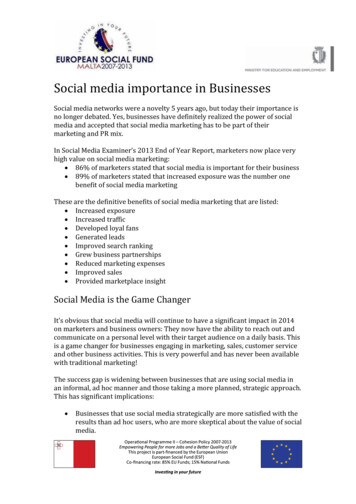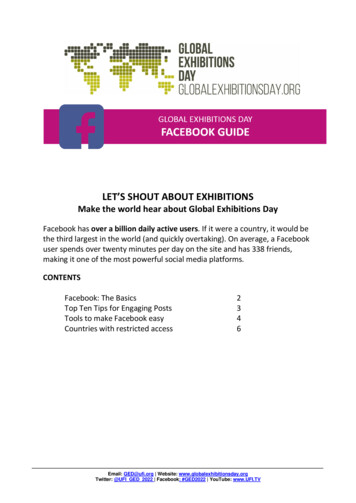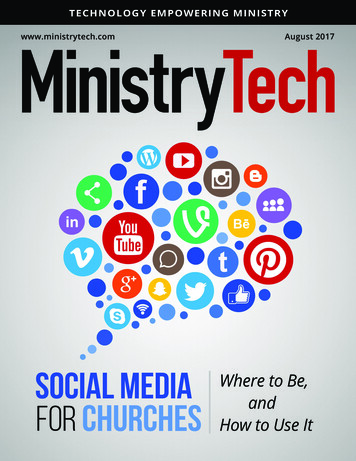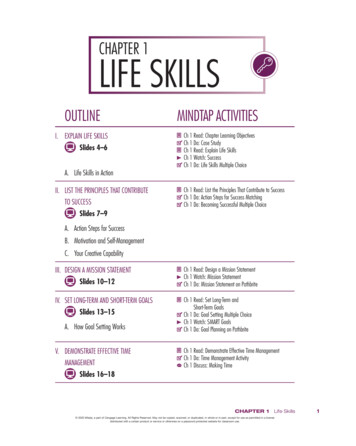
Transcription
SOCIAL MEDIA AND THEIR IMPACT ON ORGANISATIONS:BUILDING FIRM CELEBRITY AND ORGANISATIONAL LEGITIMACYTHROUGHSOCIAL MEDIAFrancesca BriaImperial College LondonImperial College Business SchoolPhD in Innovation and Entrepreneurship1
DECLARATION OF ORIGINALITYThis is to certify that:The thesis comprises my original work towards the PhD except where indicated, and appropriatereference has been made in the text to all other material used.2
COPYRIGHT DECLARATIONThe copyright of this thesis rests with the author and is made available under a CreativeCommons Attribution Non-Commercial No Derivatives licence. Researchers are free to copy,distribute or transmit the thesis on the condition that they attribute it, that they do not use it forcommercial purposes and that they do not alter, transform or build upon it. For any reuse orredistribution, researchers must make clear to others the licence terms of this work.3
ABSTRACTThis thesis examines the impact of social media on organisations, and in particular focuses onthe way firms are using social media to construct “online celebrity” and the way socialmovement organisations acquire legitimacy through a blending of offline and online illegitimateactions. This thesis embraces a perspective at the intersection between institutional theory,communications theory and strategy to deeply understand the impact of social media that enablesand constrains organisational actions. The study finds that social media are affecting theinformation-intensive environment where organisations operate. Current shifts in communicationtechnology, such as new patterns and modes of communication, provide a useful naturalexperiment to analyse how different types of organisations, including firms and social movementorganisations, are strategically adopting social media to help maintain or acquire social approvalassets.This research into social media strategy in one large technology firm and in one socialmovement organisation shows how social media may enable firms to achieve valuable strategicpositions in ways that are underexplored by current organisation literature, ultimately leading tocelebrity and legitimacy acquisition. This thesis makes several contributions to organisationalstrategy and institutional theory. First, it introduces and develops the concept of online celebrity,which is a firm’s ability to attract public attention and affective investment from networkedpublics through social media. Second, it expands our understanding of legitimacy acquisition byincluding a blending of illegitimate offline and online actions by social movement organisationsthat challenge taken for granted cultural norms, dominant frames and powerful actors. Third, itoutlines key social media tactics which focus on shaping the external organisational environmentand the cognition and perception of key audiences.This thesis also presents future paths of research that organisation and management scholarsshould consider in order to develop a more comprehensive understanding of how shifts incommunication strategies facilitate larger shifts in social institutions and in the wayorganisations construct their interaction with stakeholder audiences.Key words: social media, reputation, legitimacy, online celebrity, illegitimate actions,technology firms, social movement organisations, social media tactics, symbolic value, networksociety, online identity, switching power, external cultural resources4
ACKNOWLEDGMENTSI wish to express my sincere appreciation to all those who assisted me in the research processand supported me during my PhD.I would like to thank Prof. Markus Perkmann and Prof. Nelson Phillips for their preciousfeedback on my work and for their constant encouragement throughout these years.I would like to thank the Directors of the Doctoral Programme at Imperial College BusinessSchool, Prof. Erkko Autio, and the administrative staff, Julie Paranics, Frederique Dunnil, DonnaSutherland-Smith, and Catherine Lester.I am grateful to colleagues and Professors at the Imperial College Business School who providedconstructive discussions and feedback on my work. I am also thankful to my informants for theircollaboration on the data collection phase and made the field work possible . I am grateful to allmy other academic colleagues that provided feedback and inspiration during conferences andpresentations and to all my friends that supported me during the entire process. In particular, Iam thankful to Prof. Daniele Archibugi who directed me towards this research at ImperialCollege.Finally, I am thankful to my family for their love, care, and crucial support. Without theirencouragement my research would not have been possible.5
TABLE OF CONTENTSGENERAL INTRODUCTION . 7PAPER 1. SOCIAL MEDIA AND THEIR IMPACT ON ORGANISATIONS:A REVIEW AND INTEGRATED DISCUSSION FOR FUTURE MANAGEMENTRESEARCH .12PAPER 2. THE CONSTRUCTION OF ONLINE CELEBRITY: EXPLORING FIRMCELEBRITY BUILDING THROUGH SOCIAL MEDIA. 71PAPER 3. RETHINKING LEGITIMACY THROUGH SOCIAL MEDIA:HOW SOCIAL MOVEMENT ORGANISATIONS ACQUIRE LEGITIMACYTHROUGH A BLENDING OF ILLEGITIMATE ACTIONS AND SOCIAL MEDIATACTICS .151GENERAL CONCLUSIONS AND IMPLICATIONS .2526
GENERAL INTRODUCTIONOverall Theoretical Framework and Structure of the ThesisThe popularity and economic relevance of social media has increased over recent years, enablingmillions of users in sharing data, information and products, and affecting the way organisationsare building their businesses around connected people. Communications scholars have arguedthat institutions are highly influenced by different communication structures and processes (Innis1951; McLuhan 1962). Different authors have analysed the increasing mediatisation oforganisations and the influence that news media and other information intermediaries have onorganisations and on their relationship with external stakeholders (Carroll 2010; Fombrun 1996;Rindova and Fombrun 1999; Deephouse 2000; Rindova et al. 2007). However, despite theawareness of the central role of media in contemporary society, which affects the informationintensive environment where organisations operate, there is a lack of understanding of howinstitutional processes unfold in a mediatised society. In addition, there are few empirical studiesthat effectively demonstrate how shifts in communication patterns and strategies facilitate largershifts in social institutions and in how organisations construct their interaction with stakeholderaudiences.When I started this research it immediately became evident that in order to make sense of thebroader impact of social media on organisations it was critical to investigate the phenomenon asa socially constructed process that contributes to shaping the institutional contexts, linkingorganisations, stakeholders and institutions (Deephouse et al. 2008). Organisations are in factembedded in increasingly information intensive environments that enable and constrainorganisational actions. Neo-institutional theory provided important insights on the influence ofthe environment on the organisation of a society. The institutional approach seemed to be themost relevant to research the impact of social media on organisations, and particularly insightfulto explain key drivers underpinning these transformations in different types of organisations.However, somewhat surprisingly, organisational institutionalism has failed to adequatelyintegrate communication theory, and social media in particular, which have thus far beenoverlooked by organisational research. Social media offer especially fertile grounds to explorequestions related to the relation between modes of communication and institutional processes,potentially contributing to further expanding our knowledge of the role of communicationtechnologies in structuring institutions. This thesis adopts a perspective at the intersection of7
strategy research and institutional theory, and integrates it with communication theory to analysethe influence that social media have on diverse types of organisations. The insights provided inthis thesis contribute to the understanding of social media as a phenomenon, but mostimportantly to the investigation of how organisations are adopting social media with the aim ofincreasing the positive relationship with their audiences, thus acquiring “social approval assets”such as celebrity and legitimacy.This research is motivated by the recent significant developments of social media and theirwidespread adoption by different types of organisations (ranging from large technology firms,creative intermediaries, to social movement organisations). I was interested in the way socialmedia are affecting organisational strategies and generating new organisational tactics. Socialmedia have been investigated from a variety of perspectives, producing a considerable body ofknowledge. Still relatively unexplored through is the impact that social media have onorganisations. Furthermore, little effort has been made to integrate the outcome of research indifferent disciplines and develop a future research agenda for management and organisationstudies.In order to address this gap and generate a theoretical account of the impact of social media onorganisational celebrity and legitimacy, this work follows an inductive approach (Denzin andLincoln 2000) and employs grounded theory techniques for collecting, coding and analysing data(Glaser and Strauss 1967). The aim is to uncover unexplored social dynamics, context-specificprocesses, and social media tactics at the intersection between strategy, institutional theory andcommunication theory, contributing to these streams of research and not to generate a standalone theory detached from previous literature (Suddaby 2006). For researching such an underexplored issue, I chose an inductive theory building method, which means I had to immersemyself into the field to deeply explore the richly diverse sets of data so that I could be exposed tothe development of this fast evolving field, acquire new ideas and look for different sources thatcould inform the development of my research.The thesis is organised in three distinct but interconnected papers and it is structured as follows:8
PAPER 1 - SOCIAL MEDIA AND THEIR IMPACT ON ORGANISATIONS:A REVIEW AND INTEGRATED DISCUSSION FOR FUTURE MANAGEMENTRESEARCHIn the first paper, I compare and contrast extant literature on social media in four different fields– new media and Internet studies, computer science and information system, marketing researchand consumer culture theory, and innovation management – highlighting the fundamental tenetsand research findings of each stream of inquiry. Building on this review, the paper proposes anintegrative discussion of the phenomenon under investigation, emphasising links betweendifferent viewpoints and potential benefits to be gained by a more intense cross-fertilisationamong perspectives. I argue how organisational scholars may be in a particularly favourableposition to facilitate the integration among different perspectives and upgrade our understandingof social media and its impact for organisations.This research complements existing studies on the role of media on organisations by revealingwhat social media and their affordances do, in opposition to non-social media scenarios. Theresults of previous research need to be extended to take into account the unique new propertiesof social media such as the dialogic nature of communication, the new quality of “networkedpublics” as opposed to “audiences” or “consumers”, social media scalability and the viral effectbased on bidirectional communication, and the volatility of online identities. The originality ofthis research is its focus on social media and their impact on organisations and institutionalprocesses to explore how a strategic adoption of social media can influence organisationalstrategies of action.The first paper presents the theoretical framework for the overall research area and it identifiesareas of research to potentially expand existing literature, with a focus on future managementand organisation research agenda. It concludes with the identification of key research topics thatrepresent some kind of impact or aspect of organisations and how they use social media and howthey are affected by it.9
PAPER 2 - THE CONSTRUCTION OF ONLINE CELEBRITY:EXPLORING FIRM CELEBRITY BUILDING THROUGH SOCIAL MEDIAThe second paper investigates the way a large technology company (Intel) partner with anunconventional creative agency (VICE) to strengthen the relationship with key intermediaries,focusing on constructing cultural value and building online celebrity. This paper builds onresearch on organisational reputation and celebrity as intangible social approval assets, with astrategic value for the organisation (Fombrun and van Riel 2003; Rindova et al. 2006), andwhose value is derived from stakeholder perceptions (Rao 1994). I articulate the similarities anddifferences between reputation and celebrity. Firm celebrity in particular derives fromnonconforming and deviant behaviour that generates attention and reactions from audiences. Ithas also been argued that the media are key players in the process through providing keyresources and mass coverage (Deephouse 2000). In particular, through the diffusion ofdramatised narratives, the media construct celebrity firms that are eventually able “to attract ahigh level of public attention and generate positive emotional responses from stakeholderaudiences” (Rindova et al. 2006: 51).This study of celebrity construction through social media adoption in a large technology firmsuggests that strategy research should consider, along with other forms of capital, thedevelopment and deployment of cultural resources (Dalpiaz et al. 2010) which are pivotal inmanaging external perceptions and eventually leading to the attainment of celebrity. I extend thecelebrity theory by suggesting the concept of online celebrity that incorporates key insights fromcommunication theory and social media strategy. The emerging findings highlight that socialmedia are key in shaping and influencing the construction of online celebrity through three mainphases within a firm's strategic process; here named integration of external cultural resources,the co-construction of web-mediated cultural value, resulting in the attainment of organisationalonline celebrity. The findings demonstrate how work at the intersection of different streams ofliterature can provide insights about the role of social media in generating organisational culturalcapital and its decisive relation to online celebrity in the process of strategy formation. Thegrounded model that emerges from the observations thus advances the research concerning theuse of social media in strategy, reputation and celebrity management.10
PAPER 3 - RETHINKING LEGITIMACY THROUGH SOCIAL MEDIA:HOW SOCIAL MOVEMENT ORGANISATIONS ACQUIRE LEGITIMACY BYDELEGITIMISING OTHER ORGANISATIONSIn my third paper I turned to neo-institutional theory to understand the way social media arechallenging organisational legitimacy. Since there seems to be no rich field-based account ofhow social media tactics are used by organisations, I investigate new tactics that blend offlineand online actions not explored by previous studies and which ultimately lead to organisationallegitimacy acquisition. A rich and comprehensive understanding of how social media influencethe process of acquisition of organisational legitimacy seems to be still lacking in the literature. Iextend theory in this area by tracing social movement organisations’ illegitimate actions offlineand online, and the provoked changes in the institutional environment. In particular, by drawingon an in-depth case study on a social movement organisation, the third paper contributes toresearch on challenger movements and legitimacy acquisition through social media.This research analyses this process in three distinct campaigns carried out by Greenpeace UK inthe last two years. The choice to focus on these particular campaigns and on the integration ofsocial media in the campaigns’ broader strategy derives from the importance that keystakeholders and audiences attribute to the emerging social media environment to mobilisecollective action and direct it to the support of an organisation’s causes and values that maycontradict and challenge taken for granted norms and institutions. In order to acquire legitimacy,social movement organisations employ several illegitimate tactics offline and online to changethe perception of key constituents and aggregate the sentiment of networked publics, gainingmass scale endorsement. This study reveals new directions for research into the relationshipsbetween social movements, social media and institutional dynamics based on the describedtactics. The research points to the importance of considering the political and collectivedimensions of the relationships between social actors, organisations, and social media.The grounded model developed suggests that social movements that challenge existingframeworks are able to strategically use a set of social media tactics (namely tapping the crowdand delegitimising corporate online identity) to acquire collective support by a variety of keyconstituents. In this way they are able to exercise their role as power switchers in the networkedspace, able to connect and disconnect stakeholder networks and mobilise resources according todifferent contexts, interests, and tactics applied around specific issues, ultimately leading toorganisational legitimacy acquisition.11
SOCIAL MEDIA AND ITS IMPACT ON ORGANISATIONS:A REVIEW AND INTEGRATED DISCUSSION FOR FUTUREMANAGEMENT RESEARCHABSTRACTThe popularity and economic relevance of social media has increased over recent years, enablingmillions of users to share instantaneous data, information and media products. User-generatedcontent and the participatory web are currently the lifeblood of the Internet. Social Media isstarting to affect all organisations across different dimensions: organisations' internalcommunication, the working relationships, the relationship with their stakeholder audiences,conversations with consumers, business model innovation, and organisational reputation andlegitimacy. Multiple disciplines have analysed this phenomenon from different perspectives,producing a considerable amount of knowledge. However, the impact of social media onorganisations and the type of changes provoked by their adoption remain relatively unexplored.Furthermore, little effort has been made to integrate the outcome of research in differentdisciplines and develop an integrated theoretical framework at an organisational level that couldinform future research agenda. In this paper I compare extant literature on social media in fourdifferent fields – new media and Internet studies, computer science and information system,marketing research and consumer culture theory, and innovation management – highlighting thefundamental tenets and research findings of each stream of inquiry. Building on this review, Ipropose an integrative discussion of the phenomenon under investigation, emphasising linksbetween different viewpoints and potential benefits to be gained by a more intense crossfertilisation among perspectives. I also argue how organisational scholars may be in aparticularly favourable position to facilitate the integration among different perspectives andupgrade our understanding of social media and its impact on organisations.12
INTRODUCTIONThe popularity and economic relevance of social media has increased over recent years, enablingmillions of users to share instantaneous data, information and media products. User-generatedcontent and the participatory web are currently the lifeblood of the Internet. Thousands of socialnetworks focusing on building social relations among people emerged in the last decade toprovide people new communication and coordination tools based on social characteristics of theuse of technology. Users are creating new communication practices and contributing content tonew-media aggregators such as Facebook, Amazon, Google, eBay, and Flickr. Facebook (1.11billion active users as of March 2013), Twitter (200 million active users as of February 2013),and LinkedIn (225 million active users as of May 2013) as online social communities areunprecedented. Social media sites such as Facebook or Twitter provide a technology platform toestablish and multiply relationships between users and organisations, enabling users to becomevisible to a wide public and to expose their social networks.Social media offers huge potential for what has been defined “mass-self communication”(Castells 2009), indicating the production of knowledge that utilizes the capabilities of largenumbers of users for the solution and prediction of challenges or problems. Social networks aremonitored to discover trends, get competitive information, listen, and engage in conversationswith users and stakeholders. Thus, the ability of firms to engage and shape the relationships andconversations with consumers and customers is a key factor for the successful management ofvalue within digital semantic communication networks.Social media networks are enabling businesses to become more socially engaged, exploiting newbusiness model innovation based on firms’ ability to monetise and extract value from crowdgenerated data and content. Social media has enabled organisations to establish a strongerrelationship with the community of reference, in order to exploit the network effect and harnesscollective intelligence. The examples often presented are companies such as eBay or Amazonthat managed to build a marketplace nourished by voluntary contributions (user-driven auctionsystem or user-generated reviews) which allows the users to actively participate in the‘communication flow’ around their products (Kleiner and Wyrick 2007). Spontaneous activitiesof users and consumers outside the boundaries of the firms constitute a rare and valuableresource that sparks innovation and which companies are trying to capture and manage. Thus,organisations are focusing on social media and trying to leverage opportunities.13
As soon as social media emerged as a technical and socio-cultural phenomenon, it has beenstudied from different perspectives. In order to properly frame and understand the social mediaphenomenon, it is important for organization scholars to draw on existing perspectives and learnfrom results and insights coming from other disciplines. Yet organization researchers have untilrecently dedicated little attention to how social media influences and are influenced by socialprocesses in and around organizations, and institutional dynamics such as reputation building,legitimacy acquisition and strategy formation. This review aims at presenting the different andusually unsynchronised efforts to study and understand social media from different perspectivesand disciplines. The insights provided in this review paper can contribute to the understanding ofsocial media as a phenomenon, but most importantly to investigate how organisations are usingsocial media to engage users and consumers, with the aim of managing community generatedcontent and projects, building reputation, and initiating collective actions. Although differentdisciplines ranging from social sciences and computer sciences, together with marketingresearch, have addressed this phenomenon from different perspectives, thus producing aconsiderable amount of knowledge, it seems that little effort has been made to develop a unitaryframework that takes into account the challenges organisations are facing when confronted withthe new media-intensive environment.In this paper, I compare extant literature on social media in four different fields – new mediaand Internet studies, computer science and information system, marketing research andconsumer culture theory, and innovation management – highlighting their fundamentalassumptions. Building on this review, I propose an integrative discussion and framework of thephenomenon under investigation, emphasising links between different viewpoints, and potentialbenefits to be gained by a more intense cross-fertilisation among perspectives that identify keyareas for future management and organisation research. I conclude with a discussion of theimplications of this study and outline several opportunities to extend this research.14
Social Media DefinitionSocial media has been analysed and investigated from a variety of disciplines and perspectives,thus generating different definitions of social media. Table 1 provides a list of the mostimportant ones according to different disciplines.-----------------------Table 1 about here------------------------The emergence of new and social media is quite a recent phenomenon and became popularisedonly when the Internet became ubiquitous and accessible to consumers worldwide, giving rise tothe so called Network Society (Castells 2003). This shift implies a move from traditionalcommunication and media theory (McLuhan 1962, 1964; McQuail 1983, 1997; Lazarsfeld andKatz 1955), even if new media didn’t replace older media but converged with other mediasources (Lievrouw and Livingstone 2002). Today, in fact, as argued by Bolter and Grusin(1999), media are undergoing a process of “remediation” in which older media are continuouslyappropriated, reconstructed or absorbed by the new media, therefore simultaneously shapingfuture media and older ones (Bolter and Grusin 1999). The Social Web is able to combine innovel ways, remediate and expand communication and information possibilities that werealready present in the past. Through social communication tools users are contributing content tonew-media aggregators and big digital platforms such as Facebook, Amazon, Google, and eBay.Blogs, or other platforms specifically designed for user-generated content, represent a socialinfrastructure that can harness people's social cooperation.People’s relationships and digital identities become publicly displayed, forming a social graphthat exposes each user's connections and lists of friends and contacts. In this research, socialmedia is defined as “mass-self communication” (Castells 2010), i.e. the mass, meaning the“massive” amount of knowledge produced and in its production by the non-expert “masses”;and the production of knowledge that utilises the capabilities of large numbers of users for thesolution and prediction of challenges or problems. And “self” because the communicationhappens intersubjectively among users themselves who can broadcast news or an update to theirfriends and to a potential mass audience. The Internet is considered as an enabling infrastructurefor novel ways to organize collective action via communication technologies (Rheingold 2002).15
Mass-self communication runs on horizontal networks of interactive communication, engagingusers that “live with the Internet”, turning the Internet in the communication fabric of people'sdaily lives, for work, for personal connection, for social networking, for information, forentertainment, for politics and so on. According to Castells (2009), mass self-communicationrepresents the contemporary evolution of the Web due to fast and mobile broadband diffusion,open-source software development and applications, advanced users' interfaces and experiences.Social media is defined in the literature as the term for the ways people connect to peoplethrough computation (Lenhart et al. 2010). Users can generate their personal profile, whichincludes personal information such as location, gender, age, activities and interests, beliefs,affiliations, and other multimedia content about users' personal and professional lives.On the academic side, a considerable body of knowledge has addressed the definition, formationand evolution of social media, often using slightly different terminology to capture the nuanceswithin a diverse digital media ecosystem. The use of the term “social media” emphasizes theability of users to participate and contribute to content creation, Social media have enabled theemergence of a new participatory digital sphere based on a many-to-many communication whereusers can dialogically interact and collaborate to the creation of content shaping the flow ofcommunication (Jenkins, 2006). The use of the term "Social networking sites" emphasizes therelational and sharing aspect of the medium and can be defined as "a network of socialinteractions and personal relationships". Social media can therefore become simultaneously as“social networking sites” as: (1) A tool to support people’s real social networks (organization andextension), and (2) A tool to analyse social identity of the others (description and definition)(Riva 2010). In particular, “social network sites” refer to “web-based services that allowindividuals to (1) construct a public or semi-public profile within a bounded system, (2)articulate a list of users with whom they share a connection, and (3) view and traverse their listof connections and those made by others within the system” (Boyd and Ellison 2007, p. 1). Theterm Social Networking Site (SNS) indicates a platform (including Facebook and YouTube,thematic social networks, blogs, wikis, online forums, virtual communities, online games andvirtual worlds) that provides a range of social media services such as user-generated contentsharing, social networking, knowledge co-creation and collaborative activities (Hitwise andExperian 2010).Social networks social media social, such as Facebook and T
media are affecting organisational strategies and generating new organisational tactics. Social media have been investigated from a variety of perspectives, producing a considerable body of knowledge. Still relatively unexplored through is the impact that social media have on . acquire new ideas and look for different sources that



